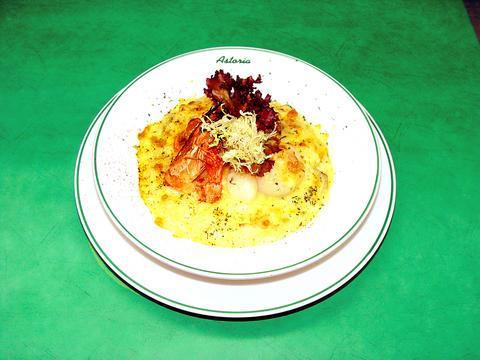A good restaurant feeds the body, but a great restaurant feeds the soul, transporting it to another place or time. The Astoria in Taipei's Wuchang Street is like a portal that takes diners back in time to 1949, to the kind of respectable cafe our Western grandmothers dressed up to lunch at. It provides a feast for the senses with its classic recipes, as well as a few new surprises.
The Astoria was reopened in July by the same family that has kept the bakery downstairs going for 55 years, to the delight of the culturati who had made the place their second home (and like family, patriarch Archiybold Chien fed some of the writers and artists in their lean years). One booth has photos of its longtime literary denizens.

PHOTO COURTESY OF THE ASTORIA
But the food stands up to the challenge of recreating a past. Four salads are offered in the mid-NT$200 price range, including a chef's salad, Russian, Caesar and fruit. The Caesar was satisfying, served with four helmeted but naked prawns. The tiny croutons, bacon and romaine were all perfectly crisp, with a dressing more sweet than redolent of garlic and anchovy.
The smoked salmon spaghetti turned out to be a handsomely made plate of fettucine topped with a wide slice of smoked salmon. Underneath were chunks of fresh salmon in a cream sauce, with a rainbow of delicately julienned peppers and onions.
The "course" menu offers fried meats and seafoods for NT$280 to NT$350. Specials (found not on the menu but on a tabletop card in Chinese only) top the price range with steak and lamb, both NT$580. They also include beef cooked in red wine for NT$380 and something that was described to me as "pancakes with cheese and vegetables" for NT$300.
This turned out to be a surprise -- a large plateful of quesadillas, served with a creamy sauce (that wasn't sour cream) and sweet salsa heady with oregano but lacking the usual smoky cumin. A slight afterburn comes from the canned jalapenos in the lighter-than-tortilla crepes, filled with chicken, cheese and julienned vegetables. You're not in the 1950s anymore. Rounding out the offerings are numerous varieties of coffee, the bakery's pastries and fruit frappes.
This is the place to take your visiting family when they've tired of noisy Chinese restaurants and want to catch their breath.

This is the year that the demographic crisis will begin to impact people’s lives. This will create pressures on treatment and hiring of foreigners. Regardless of whatever technological breakthroughs happen, the real value will come from digesting and productively applying existing technologies in new and creative ways. INTRODUCING BASIC SERVICES BREAKDOWNS At some point soon, we will begin to witness a breakdown in basic services. Initially, it will be limited and sporadic, but the frequency and newsworthiness of the incidents will only continue to accelerate dramatically in the coming years. Here in central Taiwan, many basic services are severely understaffed, and

Jan. 5 to Jan. 11 Of the more than 3,000km of sugar railway that once criss-crossed central and southern Taiwan, just 16.1km remain in operation today. By the time Dafydd Fell began photographing the network in earnest in 1994, it was already well past its heyday. The system had been significantly cut back, leaving behind abandoned stations, rusting rolling stock and crumbling facilities. This reduction continued during the five years of his documentation, adding urgency to his task. As passenger services had already ceased by then, Fell had to wait for the sugarcane harvest season each year, which typically ran from

It is a soulful folk song, filled with feeling and history: A love-stricken young man tells God about his hopes and dreams of happiness. Generations of Uighurs, the Turkic ethnic minority in China’s Xinjiang region, have played it at parties and weddings. But today, if they download it, play it or share it online, they risk ending up in prison. Besh pede, a popular Uighur folk ballad, is among dozens of Uighur-language songs that have been deemed “problematic” by Xinjiang authorities, according to a recording of a meeting held by police and other local officials in the historic city of Kashgar in

It’s a good thing that 2025 is over. Yes, I fully expect we will look back on the year with nostalgia, once we have experienced this year and 2027. Traditionally at New Years much discourse is devoted to discussing what happened the previous year. Let’s have a look at what didn’t happen. Many bad things did not happen. The People’s Republic of China (PRC) did not attack Taiwan. We didn’t have a massive, destructive earthquake or drought. We didn’t have a major human pandemic. No widespread unemployment or other destructive social events. Nothing serious was done about Taiwan’s swelling birth rate catastrophe.